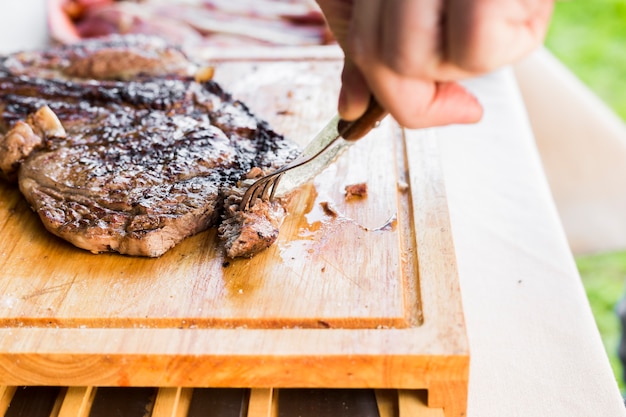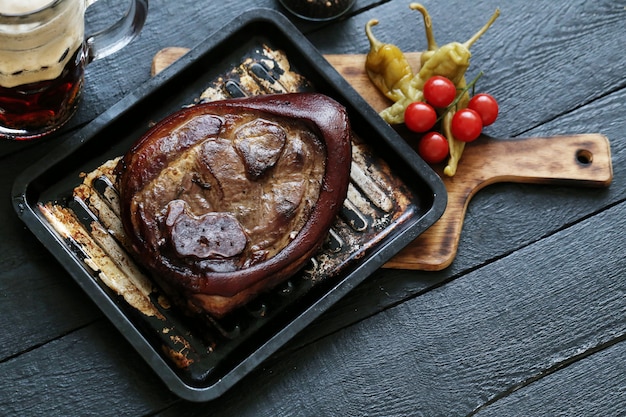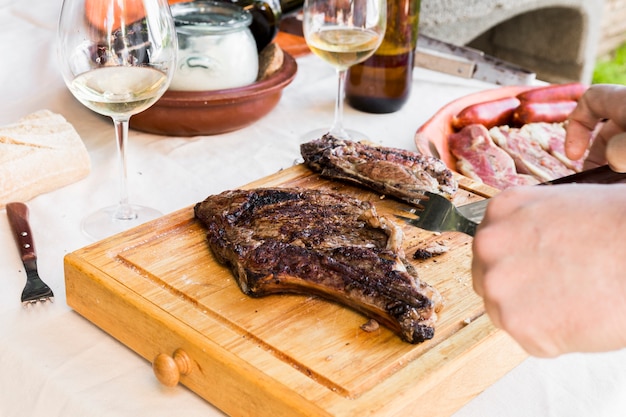(Part 1) Picking Your perfect brisket

The Anatomy of a Brisket
First things first, you need to understand the anatomy of this magnificent beast. A brisket is essentially the chest muscle of a cow, divided into two main parts: the flat and the point. The flat: This is the leaner, flatter, and more rectangular part. It's perfect for slicing thinly and serving as a main dish. The point: This is the thicker, more rounded, and fattier part. It's known for its rich flavour and tender texture.choosing the right cut
When choosing your brisket, look for a cut that's well-marbled with fat. This fat will render down during cooking, adding flavour and moisture to the meat. You'll also want to consider the size of the brisket. A smaller brisket will cook faster, while a larger one will require more time.Here’s what to look for when choosing your brisket:
- Marbling: Look for a brisket that’s well-marbled with fat throughout, which will render down during cooking and add flavour and moisture to the meat. A good rule of thumb is to choose a brisket with at least a quarter-inch of fat marbling throughout. You want to see veins of fat running through the meat, not just a thick layer on top.
- Fat Cap: A good brisket will have a thick layer of fat on top, known as the “fat cap.” This helps keep the brisket moist during cooking. A thick fat cap will render down and provide lubrication for the meat during the long cook. Look for a fat cap that's at least half an inch thick.
- Color: The meat should be a deep red color and have a slightly firm texture. Avoid brisket that's too pale or has a slimy texture. This could indicate that it's been frozen for too long.
- Smell: It should have a pleasant, meaty smell. Avoid any brisket that has a sour or off-putting smell. A slight gaminess is fine, but a strong, pungent smell suggests the meat may not be fresh.
Trimming the Fat
Now, this might sound counterintuitive, but you’ll want to trim some of the fat. This is important for even cooking and prevents the brisket from becoming greasy. Aim to remove any excess fat, but leave a thin layer over the top. You’ll use this fat cap to baste the brisket during the cooking process. When trimming, you want to remove the thickest parts of the fat cap that are not evenly distributed over the brisket, leaving a thin, even layer across the surface. You want enough fat to keep the meat moist, but not so much that it overwhelms the flavor.Seasoning the Brisket
The key to a good brisket is to not overdo it. You’re not trying to disguise the natural flavor of the beef, you’re just enhancing it. I prefer a simple salt and pepper rub, but you can add a bit of garlic powder, onion powder, and paprika if you like.Here's a simple salt and pepper rub recipe:
- 1 tablespoon kosher salt
- 1 teaspoon black pepper
- (Optional) 1/2 teaspoon garlic powder
- (Optional) 1/2 teaspoon onion powder
- (Optional) 1/2 teaspoon smoked paprika
Combine all ingredients in a bowl and rub the mixture all over the brisket. Make sure to get the seasoning under the fat cap as well. You can also use a dry rub with additional spices, like cumin, chili powder, or brown sugar, for a more complex flavor profile.
(Part 2) The Magic of Smoking

Understanding the Smoke
Smoking a brisket is all about slow, gentle cooking. The smoke adds a unique depth of flavour and creates that iconic smoky aroma. It’s like a dance between time, temperature, and smoke. The smoke interacts with the meat's proteins and sugars, creating a complex network of flavors that you won't find anywhere else.Getting Ready to Smoke
Make sure your smoker is set up properly, with a steady source of heat. The temperature should be maintained at around 225°F (107°C). This is the sweet spot for a long, slow cook. You’ll need to use good quality wood chips or chunks for the best flavour.The First Smoke
Place your seasoned brisket on the smoker, fat side up. This will allow the fat to render down and help keep the meat moist. You want to keep the brisket on the smoker for at least 6 hours, and possibly more depending on its size.The "Stall"
Here’s where things get a bit tricky. At some point during the cook, the brisket will hit what’s known as the “stall.” This is when the internal temperature plateaus and refuses to go up. This is a natural part of the process, caused by the meat releasing moisture as it cooks. This moisture evaporates, cooling the surface of the meat and slowing down the cooking process.Wrap It Up
After the brisket has stalled, it’s time for the “wrap.” You can use butcher paper or foil. This helps create a steamy environment that will accelerate the cooking process and ensure a juicy and tender result. Wrapping the brisket creates a moist environment that traps the steam and allows the meat to continue cooking evenly.(Part 3) The Art of Patience

Monitoring the Brisket
Keep a close eye on your brisket while it’s cooking. You’ll need to check the temperature regularly and add more wood chips as needed. Don’t be afraid to adjust the smoker temperature as needed to maintain a steady 225°F (107°C). You can use a meat thermometer with a probe to monitor the internal temperature of the brisket. Aim for an internal temperature of 160°F (71°C) before wrapping the brisket.The "Probe Test"
The probe test is your best friend when it comes to determining if your brisket is cooked. Aim for an internal temperature of 195°F (91°C) in the thickest part of the meat. This temperature ensures that the meat is cooked through and tender. You can use a meat thermometer with a probe to check the internal temperature of the brisket. Insert the probe into the thickest part of the meat, ensuring it's not touching any bone.Resting Time
Once your brisket reaches the desired temperature, take it off the smoker and wrap it in foil or butcher paper. Let it rest for at least 2 hours. This allows the juices to redistribute and ensures a tender, juicy result. Resting the brisket is essential for allowing the meat to relax and absorb the juices that have been released during cooking.(Part 4) Slicing and Serving
The Final Cut
Once the brisket has rested, it’s time for the grand finale – slicing! Use a sharp knife and slice against the grain. This will make the meat easier to chew and result in a more tender texture. Slicing against the grain means cutting across the muscle fibers, which helps to break them down and make the meat easier to chew.The Presentation
A beautifully sliced brisket is a sight to behold. If you’re feeling fancy, you can arrange the slices on a platter with some fresh herbs, like rosemary or thyme. You can also use a variety of garnishes, such as sliced onions, pickled jalape??os, or fresh cilantro, to add a touch of color and flavor.The Sides
Brisket is often served with a variety of sides, like coleslaw, baked beans, potato salad, and mac and cheese. It’s a feast for the senses!(Part 5) Mastering the Brisket: Tips and Tricks
Temperature Control
Maintaining a steady temperature in your smoker is crucial for even cooking. Use a digital thermometer to monitor the smoker temperature and adjust the vents as needed. You can use a combination of top and bottom vents to control the temperature in your smoker. Open the top vents to increase the heat and close them to decrease the heat. Adjust the bottom vents to control the airflow.Wood Choice
The type of wood you use for smoking will influence the flavour of your brisket. I prefer hickory for a classic smoky flavour, but you can also use pecan, oak, or mesquite. Hickory is known for its strong, bold flavor, while pecan is milder and sweeter. Oak provides a more balanced flavor, and mesquite has a strong, almost earthy flavor. Experiment with different woods to find your favorites.Basting
Basting your brisket with a mixture of apple cider vinegar and water every hour or so will help keep it moist. The apple cider vinegar adds a tangy flavor and helps to break down the tough proteins in the meat.The "texas crutch"
This is a popular technique that involves wrapping the brisket in foil during the last few hours of cooking. It helps to accelerate the cooking process and ensure a tender result. The Texas Crutch creates a moist environment that helps to steam the meat and tenderize it.(Part 6) Brisket Beyond the Barbecue
Brisket Hash
A delicious and hearty breakfast dish made with diced brisket, potatoes, and onions.Brisket Tacos
A crowd-pleasing favourite, brisket tacos are perfect for a casual meal.Brisket Chili
Brisket adds a depth of flavour to this classic comfort food.(Part 7) The Brisket Experience: A Personal Journey
My first brisket experience was a disaster. I thought I knew what I was doing, but the result was dry and tough. I was so disappointed. But I didn’t give up. I read books, watched videos, and experimented until I finally cracked the code. The joy of a perfectly cooked brisket is indescribable. It’s a combination of textures and flavours that’s hard to beat. It’s a labour of love, a testament to patience and perseverance.(Part 8) FAQs
1. What type of wood is best for smoking brisket?
Hickory is a classic choice for smoking brisket, but pecan, oak, and mesquite are also great options. It really comes down to personal preference. Hickory is known for its strong, bold flavor, while pecan is milder and sweeter. Oak provides a more balanced flavor, and mesquite has a strong, almost earthy flavor. Experiment with different woods to find your favorites.
2. How long does it take to smoke a brisket?
The cooking time for a brisket will vary depending on the size of the cut and your smoker. It can take anywhere from 8 to 16 hours, or even longer. A general rule of thumb is to allow about 1.5 hours of cooking time per pound of brisket. So, a 10-pound brisket will take about 15 hours to cook.
3. Can I use a grill to cook brisket?
You can cook a brisket on a grill, but it’s best to use a smoker for the best results. If you don’t have a smoker, you can try using the “low and slow” method on your grill. You can use the indirect heat method on a gas grill or set up a charcoal grill with a two-zone fire, using one side for cooking and the other side for indirect heat.
4. What should I do if my brisket stalls?
Don’t panic! The “stall” is a natural part of the brisket cooking process. The best thing to do is to wrap the brisket in foil or butcher paper and let it continue cooking until it reaches the desired temperature. The stall will eventually pass, and the internal temperature of the brisket will start to rise again.
5. What’s the best way to store leftover brisket?
Once the brisket has cooled, wrap it tightly in plastic wrap or foil and store it in the refrigerator for up to 3 days. You can also freeze it for up to 3 months. You can also slice the brisket and store it in an airtight container in the refrigerator or freezer.
(Part 9) The Final Word
Smoking a brisket is an art form. It takes patience, skill, and a bit of love. But the rewards are worth it. So, grab your smoker, your favourite rub, and get ready to create a brisket masterpiece. You might just surprise yourself.Everyone is watching

Prime Rib Roast Cooking Time Chart: Per Pound Guide
Cooking TipsPrime rib roast. Just the name conjures images of lavish dinners, crackling fires, and hearty laughter. It’s ...

How Long to Bake Potatoes in the Oven (Perfect Every Time)
Cooking TipsBaked potatoes are a staple in my kitchen. They're incredibly versatile, delicious, and surprisingly easy to m...

Perfect Rice Every Time: The Ultimate Guide to Cooking Rice
Cooking TipsAs a self-proclaimed foodie, I've always been a bit obsessed with rice. It's the foundation of countless cuisi...

The Ultimate Guide to Cooking Asparagus: Tips, Techniques, and Recipes
Cooking TipsAsparagus. The mere mention of this spring delicacy conjures up images of vibrant green spears, crisp and burs...

Ultimate Guide to Cooking the Perfect Thanksgiving Turkey
Cooking TipsThanksgiving. Just the word conjures up images of overflowing tables laden with delicious food, the scent of r...
